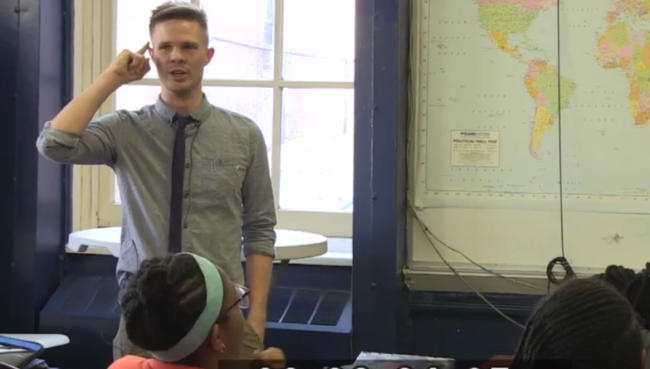05.15.19How Does Pacing Work? Ask Ben Esser!

Next year we’re re-working our Engaging Academics workshop to spend more time on the techniques teachers use to manage their Pacing–to make a lesson feel fresh,exciting and new even while it lingers on a key topic for a sustained period of time–to make learning substantive and rigorous but to also ensure sustained attention from students.
This clip of from Ben Esser’s classroom at Achievement First East New York Middle School models a lot of the topics we’ll be talking about.
Esser.PacingMOP from TLAC Blog on Vimeo.
One of the key things Ben does here is shift formats but maintain topic: The topic is reading for Laurie Halse Anderson’s ironic tone in a section of her novel Chains. That’s all students do: sustained focus on that one topic of academic merit. But they engage that topic in a variety of formats. They [just before the video starts] read it aloud. Then they read it again silently and mark it up. Then they discuss in a Turn and Talk. Then they unpack it whole group. Then they write again in summary–a Stamp. It’s an illusion–“the illusion of speed” that you get. It feels fast and engaging because Ben is able to shift the format of their engagement with the content easily and frequently, but what you also get is sustained intellectual focus.
Last week I posted a video from Denarius Frazier’s classroom. The theme was ‘Academic Systems.’ When the teacher maps out a right way to do the behaviors students do over and over in the classroom they happen like clockwork and the result is more time for and focus on learning. You can see that in Ben’s classroom too. He says, “Talk to your partner” and a second later everyone is mid-discussion. The room crackles to life. What you’re seeing there, in other words, is a habit. And in fact it’s one of the primary reasons he’s able to shift ways of engaging the text efficiently. Each transition–from reading to Turn and Talk to discussing to writing their Stamp–takes a second or two and involves no disruptions or distractions. As Ben shows, routinized procedures let you engage and involve students in real work.
I’ve written in the past about how a Cold Call ‘backstops’ high ratio activities like a Turn and Talk. The Turn and Talk involves everyone but the Cold Call afterwards adds a bit of gentle accountability for making good use of it. But Ben’s video shows the opposite is also true. Having the chance to rehearse, students are more likely to be prepared and ready and therefore to see the Cold Call as a reward.
And his technique on his Cold Call is great here. Coming out of the the Turn and Talk he calls on Neveah. “Can you explain why that final line was sarcastic?” His language is so inclisive- it shows faith in Neveah. Can you explain this to us? His second Cold Call is of Michaela and it’s even more inclusive. “Michaela, I thought you had a really great way of putting what Isabella is saying…” makes it clear that 1) he’s listened carefully during the Turn and Talk and 2) he’s calling on Michaela because he thinks her answer is insightful. An inclusive Cold Call signals to a student her importance: of all the people in the room, it’s important that we hear from just you right now.
A last tiny moment I liked a lot: Ben says, at one point, “I will take hands here…” He’s communicating to his students there how to participate. Seems so obvious; works out to be so important. I’ll take hands here reminds students not to call out but also that the way they are expected to participate shifts–now it’s hands; later it will be Cold Call. This idea we call Means of Participation. When students know how to participate they’re more likely to do it in the manner we want.
Well done, Ben and your students, and thanks for sharing
